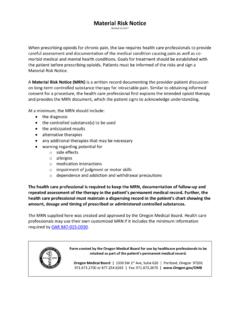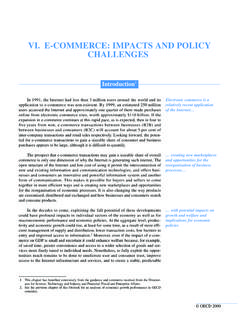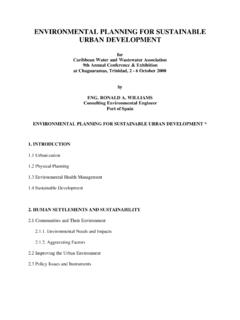Transcription of A Guide to the Removal-Fill Permit Process - oregon.gov
1 2019 REMOVAL- FILL Guide A Guide to the Removal-Fill Permit Process Chapter 1: Working with the Aquatic Resource Management Program Chapter 2: When is a Permit Required? Chapter 3: What Activities are Exempt? Chapter 4: Planning Ahead Chapter 5: How to Apply for a Permit Chapter 6: Processing the Removal-Fill Permit Application Chapter 7: Emergency Permits Chapter 8: Compensatory Mitigation Chapter 9: Monitoring the Compensatory Mitigation Site This Guide addresses existing laws and rules governing Removal-Fill activities in oregon and provides practical tips for complying with Department of State Lands regulations. It explains agency practices but does not take the place of or override regulations. The reader is cautioned to consult agency regulations first and to rely on this Guide to help understand those regulations and complete Permit applications. Consultation with agency staff early in the project s development is strongly encouraged.
2 oregon Department of State Lands 775 Summer Street, NE Suite 100 Salem, oregon 97301-1279 (503) 986-5200 Contents Chapter 1: Working with the Aquatic Resource Management Program - At a Glance .. 4 Organization of the Aquatic Resource Management Program .. 5 How the Aquatic Resource Management Program Works with Other Entities .. 6 Permit and Authorization-Related Services Provided by the Aquatic Resource Management Program .. 13 Wetland and Waterway Mitigation Grants .. 15 Requesting Public Records .. 15 Reporting a Suspected Violation .. 16 Participating in Agency Improvements .. 17 Requesting Training or Speakers .. 18 Registering a Complai nt or Compliment .. 18 Chapter 2: When is a Permit Required? At a Glance .. 0 Waters of this State - Types of Jurisdictional Waters and Their Boundaries .. 1 Definition of Removal and Fill .. 12 Removal-Fill Volume Thresholds .. 13 Calculating Removal-Fill Volumes .. 15 Special Situations: Activities That Cannot Be Permitted by Rule or Law.
3 18 Chapter 3: What Activities are Exempt? At a Glance .. 0 State Forest Management Practices .. 1 Fills for Construction, Operation and Maintenance of Certain Dams and Water Diversion Structures .. 3 Fill or Removal for a Change in the Point of Diversion .. 3 Navigational Servitude (Maintenance of the Navigational Channel) .. 4 Maintenance or Reconstruction of Water Control Structures .. 4 Maintenance or Emergency Reconstruction of Roads and Transportation Structures 5 Prospecting and Non-Motorized Activities within Designated Essential Indigenous Anadromous Salmonid Habitat .. 6 Fish Passage and Fish Screening Structures in Essential Indigenous Anadromous Salmonid Habitat .. 7 Removal of Large Wood .. 8 Certain Voluntary Habitat Restoration Activities .. 8 Exemptions in State Scenic Waterways .. 10 Agricultural Exemptions .. 11 Examples of Normal Farming and Ranching Activities .. 13 Special Situations: Railroads, Tribal Lands and Environmental Remedial Actions .. 16 Chapter 4: Planning Ahead - At a Glance.
4 0 Identifying Regulated Waters on the Project Site .. 1 Retaining Professional Consultant Services .. 6 Exploring Alternatives to Avoid and Minimize Impacts .. 7 Planning to Mitigate for Unavoidable Impacts .. 10 Pre-design Permit Scoping: Identifying Other Permits and Their Requirements .. 11 Pre-application Meetings .. 12 Chapter 5: How to Apply for Authorizations At a Glance .. 0 Types of Permits .. 1 Completing the Application Forms .. 13 General Authorization Notification Instructions .. 25 Placer Mining GA .. 27 Emergency Permit .. 28 Permit Waivers and Facility Siting Permits .. 28 Application Fees .. 29 Chapter 6: Processing the Removal-Fill Permit Application At a Glance 0 Processing General Authorization Notifications .. 3 Processing Individual Permit and General Permit Applications .. 5 Term and Expiration of the Permit .. 16 Permit Renewal and Transfer .. 17 Modifying a Permit .. 20 Special Permitting Situations ( Permit Waivers and Facility Siting Permits) .. 21 Permit -Related Appeals.
5 23 Chapter 7: Emergency Permits At a Glance .. 0 What is an Emergency? .. 1 The Procedure for Obtaining an Emergency Permit .. 1 After the Emergency .. 5 Chapter 8: Mitigation- At a 7 Compensatory Mitigation Planning for Wetlands, Streams, Tidal and Non-Tidal Waters, and Aquatic Resources of Special concern (ARSC)..1 Evaluate Project Impacts .. 1 Select the Appropriate CM .. 1 Protocol for Eligibilty and Mitigation Advance Mitigation Credit for Piling Chapter 9: Monitoring the Compensatory Mitigation Site - At a Glance0 Monitoring Methods .. 2 Data Analysis Standards .. 6 Monitoring Reports .. 6 Monitoring Duration .. 10 Appendix A Preparing the Alternatives Analysis .. 1 YOUR COMMENTS: - Use this link to e-mail comments regarding the Removal-Fill Guide to the Department: Chapter 1: Working with the Aquatic Resource Management Program - At a Glance Organization of the Aquatic Resource Management Program The Aquatic Resource Management Program (ARM) is made up of two units: Operations Unit (including Removal-Fill regulatory, proprietary and jurisdictional disciplines) and the Planning and Policy Unit.
6 Staff duties and links to co ntact information are provided. How the Aquatic Resource Management Program Works with Other Entities The ARM coordinates with numerous local, state and federal agencies and other entiti es in administering the Removal-Fill Permit program and the state s ownership of certain waterways in oregon . Permit and Authorization-Related Services Provided by the Aquatic Resource Management Program The ARM provides a variety of se rvices to su pport the Removal-Fill Permit Process including: wetland determinations, wetland delineation report review, responding to wetland land use notic es, co nducting pre-applica tion meetings and providing assistance for Permit applica tion processing. The ARM also administers the state s ownership of certain waterways in oregon including the issuance of leases, licenses, easements and registrations. Wetland and Waterway Mitigation Grants Grants are provided to construct state-sponsored mitigation projects related to the payment in-lieu and in-lieu fee mitigation programs.
7 Requesting Public Records Most records generated by DSL are public reco rds and available upon request. Depending on the extent of the request, there may be a fee. Reporting a Suspected Violation The ARM investi gates co mplaints of alleged Removal-Fill violations and unauthorized use of state-owned waterways. Certain information is essential to facilitate violation investi gation and handling. Participating in Agency Improvements Members of the public are invited to participate in a variety of efforts to improve the ARM. Requesting Training or Speakers Speakers and trainers are available for a variety of ARM-related topics. Registering a Complai nt This secti on provides information on how to report a co mplaint rel ated to ARM performance. Acronyms RFG Chapter 1: Working With the ARM Page 1-5 Chapter 1: Working with the Aquatic Resource Management Program DSL is organized into three program areas: Aquatic Resource Management, Common School Fund Properties and Business Operations and Support Services.
8 In addition, DSL administers the South Slough National Estuarine Research Reserve in Charleston in partnership with NOAA. A more detailed description of the Department can be found on the DSL website. The mission of the Aquatic Resources Management Program (ARM) is to conserve, restore and protect the waters of this state and the ecosystem services they provide through implementation of the State s Removal-Fill and wetlands planning and conservation laws. The ARM program also manages State-owned waterways to preserve the public trust rights of navigation, fishing, and recreation. The ARM implements its mission while allowing responsible, sustainable economic development and exercise of private property interests. Waters are protected for their contribution to aquatic life and habitats, fisheries, aquatic-based economies, public recreation, navigation, commerce, water quality, floodwater storage and other natural resource functions and values. Organization of the Aquatic Resource Management Program The ARM is managed by a Deputy Director and is organized into two units: the Operations Unit and the Planning and Policy Unit.
9 The Operations Unit The Operations Unit implements the Permit program for conducting Removal-Fill acti vities in wetlands and waterways and the proprietary program for authorizing uses of state-owned waterways. The operations unit is divided into two geographic regions: the northern region (comprised of northwest and metro regional teams), southern region (comprised of mid-west, southwest, and eastern regulatory regional teams). Each regional team incl udes the following personnel: Aquatic Resource Coordinators are resp onsible for processing Removal-Fill Permit applica tions, handling complaints of unauthorized acti vities, and co mpliance monitoring of permits. Proprietary Coordinator are responsible for processing and managing leases, licenses, easements and registrations for uses of state-owned waterways Jurisdictional Coordinator are responsible for reviewing wetland land use notices, reviewing wetland delineation reports and preparing jurisdictional determinations.
10 In addition, there is o ne Aquatic Resource Coordinator that serves as the oregon Department of Transportation liaison for state transportation Removal-Fill permits. Acronyms RFG Chapter 1: Working With the ARM Page 1-6 The Planning and Policy Unit The Planning and Policy unit develops aquatic resource management policies, provides certain wetland planning services to communities and provides technical specialist services to support the work of the operations unit. It includes the following personnel: Wetlands Planner: Serves as the technical lead for wetland conservation planning and protection programs. In coordination with the Aquatic Resource Specialist, assists local and regional governments, state agencies and federal agencies developing wetland protection plans and programs. Mitigation Specialist-1: Serves as the technical expert and interdisciplinary specialist to provide technical guidance to supervisors, staff and peers from other agencies on all subjects related to wetland and waterways ecology and compensatory mitigation.
















